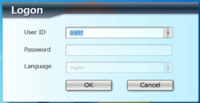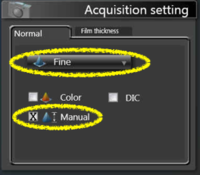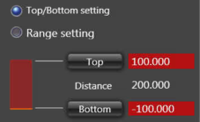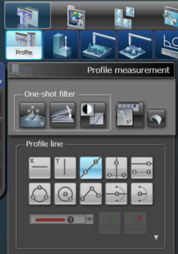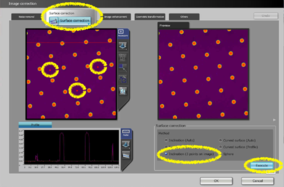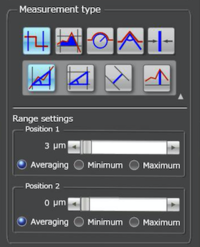Difference between revisions of "Olympus LEXT OLS4000 Confocal uScope - Quick Start"
(inserted images, partially done) |
m (clarified log off button) |
||
| (One intermediate revision by the same user not shown) | |||
| Line 26: | Line 26: | ||
# Ensure no sample is inserted, and microscope objectives are lifted away from the stage – use the coarse focus knob to lift the objectives to a safe height & Lock it, if needed. Then press “OK” on the warning & wait for motor initialization. |
# Ensure no sample is inserted, and microscope objectives are lifted away from the stage – use the coarse focus knob to lift the objectives to a safe height & Lock it, if needed. Then press “OK” on the warning & wait for motor initialization. |
||
# At the login screen, click “OK” to login as ''Guest''. |
# At the login screen, click “OK” to login as ''Guest''. |
||
| + | ## [[File:Olympus LEXT - login guest.png|frameless|200x200px]] |
||
## System should automatically display the “Acquisition” tab |
## System should automatically display the “Acquisition” tab |
||
| Line 39: | Line 40: | ||
## '''Make sure sample's TOP surface is in focus before Stepping up in objectives/magnification, to prevent crashing.''' |
## '''Make sure sample's TOP surface is in focus before Stepping up in objectives/magnification, to prevent crashing.''' |
||
## The higher the magnification, the better the height resolution. |
## The higher the magnification, the better the height resolution. |
||
| − | # Click the Laser imaging mode [[File:Olympus LEXT - laser imaging button.png|frameless|50x50px]] |
+ | # Click the Laser imaging mode button [[File:Olympus LEXT - laser imaging button.png|frameless|50x50px]] |
# Readjust electronic focus until the sample surface lights up. |
# Readjust electronic focus until the sample surface lights up. |
||
| − | ## May need to adjust laser Brightness (vertical tab on image pane), for max brightness but not saturating can use “Saturation Highlighting” to show this <<pic of saturation highlighting>> |
+ | ## May need to adjust laser Brightness (vertical tab on image pane), for max brightness but not saturating can use “Saturation Highlighting” to show this <code><<pic of saturation highlighting>></code> |
=== Acquisition Settings / Scan Range === |
=== Acquisition Settings / Scan Range === |
||
| − | + | # Set the Acquisition Settings to [''Fine''▽] & [√] ''Manual, like so:'' |
|
| + | ## [[File:Olympus LEXT - acquisition settings - Fine, manual annot.png|200x200px]] |
||
| − | |||
| − | + | ## [√] Color mode will scan the in color mode and then in laser mode, and superimpose the true-color image onto the 3D image. |
|
| + | # Expand the [+] on the right of the image and enable ''Saturation Highlighting'' |
||
| − | |||
| − | + | ## [[File:Olympus LEXT - Saturation Highlighting button highlighted.png|frameless|201x201px]] |
|
| + | # Focus ⇓on the lowest surface of your sample. Go a few mouse-wheel clicks below that focus point until lowest surface has reduced in brightness and click the [Bottom] button to save this Z height as the lower point of the scan range. |
||
| − | |||
| − | + | # Focus ⇑on the highest surface, and go a few clicks above that until brightness decreases, and click the [Top] scan range button. |
|
| ⚫ | |||
| − | |||
| ⚫ | |||
| − | 3) Focus ⇑on the highest surface, and go a few clicks above that until brightness decreases, and click the [Top] scan range button. |
||
| + | ## [[File:Olympus LEXT - Top-Bottom Setting.png|alt=Olympus LEXT - Top-Bottom Setting buttons|none|thumb|200x200px|Top & Bottom focus range buttons for Manual mode]] |
||
| − | |||
| + | # Click [Acquisition] to perform the scan [[File:Olympus LEXT - Acquisition Button.png|frameless|150x150px]] |
||
| ⚫ | |||
| ⚫ | |||
| − | |||
| ⚫ | |||
| − | |||
| − | 4) Click [Acquisition] to perform the scan |
||
| − | |||
| ⚫ | |||
=== Measure Height Profile === |
=== Measure Height Profile === |
||
| − | + | # Switch to the [Measure] tab at the top [[File:Olympus LEXT - Imaging + Measurement Buttons.png|frameless|222x222px]] |
|
| + | # Use Profile > 2-point mode[[File:Olympus LEXT - Profile 2-point Buttons.png|alt=Olympus LEXT - Measurement: Profile 2-point Buttons|none|thumb|254x254px]] |
||
| − | |||
| ⚫ | |||
| − | 2) Use Profile and 2-point modes <<pics of these buttons>> |
||
| + | # Optional: level the surface (done automatically, but sometimes can be better) |
||
| − | |||
| + | ## [Image Correction] > (•) 3-Point > ''Click 3 points on image on same surface''> [Execute] [[File:Olympus LEXT - Image Correction button.png|alt=Olympus LEXT - Image Correction button|none|thumb|205x205px|[Image Corrections] button]] |
||
| ⚫ | |||
| + | ## [[File:Olympus LEXT - 3-point Leveling Screen highlighted.png|alt=Olympus LEXT - 3-point Leveling Screen highlighted|none|thumb|284x284px|3-point Leveling Screen with relevant options highlighted]] |
||
| − | |||
| ⚫ | |||
| − | 3) Optional: level the surface |
||
| ⚫ | |||
| − | |||
| + | ### [[File:Olympus LEXT - Cursor Averaging.png|alt=Olympus LEXT - Cursor Averaging Panel|none|thumb|247x247px|Cursor Averaging Panel]] |
||
| − | a) [Surface Correction] > (•) 3-Point > ''Click 3 points on image on same surface''> [Execute] <<pics of these buttons>> |
||
| + | ## Optional: Save [[File:Olympus LEXT - Save File button.png|frameless|45x45px]] as Screenshot or LEXT file (for later analysis) |
||
| − | |||
| ⚫ | |||
| − | |||
| ⚫ | |||
| − | |||
| − | b) Optional: Save <<disk icon>>> Screenshot or LEXT file |
||
=== Shutdown at End of Session === |
=== Shutdown at End of Session === |
||
| + | # [[File:Olympus LEXT - Imaging Button.png|frameless|99x99px]] [Imaging] at top > [[File:Olympus LEXT - Color imaging button.png|frameless|50x50px]] Color <<color icon>> > [[File:Olympus LEXT - 5x objective button.png|frameless|36x36px]] 5x > [[File:Olympus LEXT - sample load position button.png|frameless]]Sample Exchange |
||
| − | 1) [Imaging] at top > Color <<color icon>> > 5x > Sample Exchange <<exchange button>> |
||
| + | # Log Off (NOT the [X] button!) [[File:Olympus LEXT - log out-close buttons highlighted.png|frameless|88x88px]] |
||
| − | |||
| + | ## This saves each user a few minutes of boot-up time |
||
| − | 2) Log Off <<key icon>> (NOT exit <<[X] icon>>) |
||
| ⚫ | |||
| − | |||
| ⚫ | |||
Latest revision as of 18:19, 25 July 2018
Demis D. John –– 2018-07-19
Do not use the LEXT unless trained first!
You MUST be officially trained on this tool before you are allowed to use it!
These instructions are a quick-reference for users who have already received the full training.
Quick-Start General Procedure
In order to acquire a profile height measurement, you must do the following:
1) Get the sample surface in focus with the regular “color” optical microscope & lock the focus knob
2) Switch to “laser” mode & readjust the focus
3) Specify the bottom and top range for the focus motor to scan over & acquire the scan data (in Fine/Manual mode)
4) In the “Measure” tab, Specify a region on the image of which to take a profile
5) Move the cursors to the desired step-height measurement positions
Quick-Start Detailed Procedure
Initial Setup
Make sure microscope is raised and stage is away from the objectives in the “Sample Exchange” position. Make sure software is started (should show a Login screen). If this is not the case, do the following:
- Open the software “OLS4000”.
- Ensure no sample is inserted, and microscope objectives are lifted away from the stage – use the coarse focus knob to lift the objectives to a safe height & Lock it, if needed. Then press “OK” on the warning & wait for motor initialization.
- At the login screen, click “OK” to login as Guest.
Load & focus on sample
- Place your sample near the center of the stage.
- Make sure 5x objective is selected and objectives will not hit stage if motors move down. If unsure, click “Cancel” on the “Move to Z reference position” dialogue, and lift the objectives using the manual focus knob.
- Click the “Scan Position” button
 to move the stage to center
to move the stage to center - System should already be imaging live in Color mode. If not, click the “Color” imaging button
 , and ensure the “Live” window-tab has a halo around it by clicking on it, like so:
, and ensure the “Live” window-tab has a halo around it by clicking on it, like so: 
- Focus on the sample surface by using the black manual focus knob first, unlocking/re-locking if needed. This prevents the electronic focus motor from hitting it’s limit during imaging.
- Make sure to engage the focus “Lock” ring (finger-tight only), otherwise the focus will drift.
- Fine-Focus (electronic) by using the Mouse-Wheel (Right-click the live image to set wheel to Coarse focus), or by using the “Focus” up/down arrows on the right of the image.
- Use the joystick to drive to feature of interest.
- Make sure sample's TOP surface is in focus before Stepping up in objectives/magnification, to prevent crashing.
- The higher the magnification, the better the height resolution.
- Click the Laser imaging mode button

- Readjust electronic focus until the sample surface lights up.
- May need to adjust laser Brightness (vertical tab on image pane), for max brightness but not saturating can use “Saturation Highlighting” to show this
<<pic of saturation highlighting>>
- May need to adjust laser Brightness (vertical tab on image pane), for max brightness but not saturating can use “Saturation Highlighting” to show this
Acquisition Settings / Scan Range
- Set the Acquisition Settings to [Fine▽] & [√] Manual, like so:
- Expand the [+] on the right of the image and enable Saturation Highlighting
- Focus ⇓on the lowest surface of your sample. Go a few mouse-wheel clicks below that focus point until lowest surface has reduced in brightness and click the [Bottom] button to save this Z height as the lower point of the scan range.
- Focus ⇑on the highest surface, and go a few clicks above that until brightness decreases, and click the [Top] scan range button.
- If you see any regions of the sample surface reach saturation anywhere in the scan range, lower the image brightness using the Brightness arrows on the right of the imaging panel.
<<pic of brightness buttons>>. - Higher brightness reduces noise, but saturation reduces accuracy of surface height detection.
- If you see any regions of the sample surface reach saturation anywhere in the scan range, lower the image brightness using the Brightness arrows on the right of the imaging panel.
- Click [Acquisition] to perform the scan

- 200 height steps takes about ~30sec. Watch out for excessively high scan steps that could take a long time.
Measure Height Profile
- Switch to the [Measure] tab at the top

- Use Profile > 2-point mode
- Click two points on your image to extract profile
- Optional: level the surface (done automatically, but sometimes can be better)
- [Image Correction] > (•) 3-Point > Click 3 points on image on same surface> [Execute]
- Place cursors on height profile & observe “Height” value in corner.
